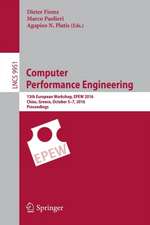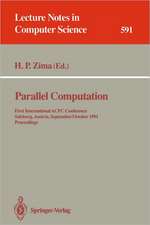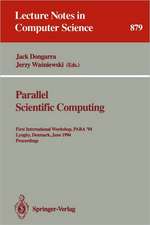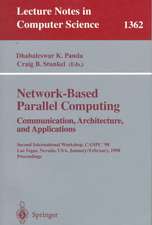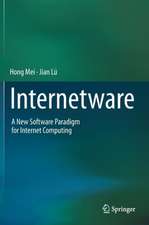The Codesign of Embedded Systems: A Unified Hardware/Software Representation: A Unified Hardware/Software Representation
Autor Sanjaya Kumar, James H. Aylor, Barry W. Johnson, Wm.A. Wulfen Limba Engleză Paperback – 22 oct 2011
To address the problems described above, a cooperative design approach, one that utilizes a unified view of hardware and software, is described. This approach is called hardware/software codesign. The Codesign of Embedded Systems develops several fundamental hardware/software codesign concepts and a methodology that supports them. A unified representation, referred to as a decomposition graph, is presented which can be used to describe hardware or software using either functional abstractions or data abstractions. Using a unified representation based on functional abstractions, an abstract hardware/software model has been implemented in a common simulation environment called ADEPT (Advanced Design Environment Prototyping Tool). This model permits early hardware/software evaluation and tradeoff exploration. Techniques have been developed which support the identification of software bottlenecks and the evaluation of design alternatives with respect to multiple metrics. The application of the model is demonstrated on severalexamples. A unified representation based on data abstractions is also explored. This work leads to investigations regarding the application of object-oriented techniques to hardware design.
The Codesign of Embedded Systems: A Unified Hardware/Software Representation describes a novel approach to a topic of immense importance to CAD researchers and designers alike.
| Toate formatele și edițiile | Preț | Express |
|---|---|---|
| Paperback (1) | 1271.93 lei 43-57 zile | |
| Springer Us – 22 oct 2011 | 1271.93 lei 43-57 zile | |
| Hardback (1) | 1281.49 lei 43-57 zile | |
| Springer Us – 30 noi 1995 | 1281.49 lei 43-57 zile |
Preț: 1271.93 lei
Preț vechi: 1589.91 lei
-20% Nou
Puncte Express: 1908
Preț estimativ în valută:
243.38€ • 254.79$ • 201.38£
243.38€ • 254.79$ • 201.38£
Carte tipărită la comandă
Livrare economică 07-21 aprilie
Preluare comenzi: 021 569.72.76
Specificații
ISBN-13: 9781461285533
ISBN-10: 1461285534
Pagini: 304
Ilustrații: XXVI, 274 p.
Dimensiuni: 155 x 235 x 16 mm
Greutate: 0.43 kg
Ediția:Softcover reprint of the original 1st ed. 1996
Editura: Springer Us
Colecția Springer
Locul publicării:New York, NY, United States
ISBN-10: 1461285534
Pagini: 304
Ilustrații: XXVI, 274 p.
Dimensiuni: 155 x 235 x 16 mm
Greutate: 0.43 kg
Ediția:Softcover reprint of the original 1st ed. 1996
Editura: Springer Us
Colecția Springer
Locul publicării:New York, NY, United States
Public țintă
ResearchCuprins
1: Introduction.- 1.1 Motivation for Hardware/Software Codesign.- 1.2 System Design Considerations.- 1.3 Research Scope and Overview.- 1.4 A Road Map of the Monograph.- 2: Hardware/Software Background.- 2.1 Embedded Systems.- 2.2 Models of Design Representation.- 2.3 The Virtual Machine Hierarchy.- 2.4 Performance Modeling.- 2.5 Hardware/Software Development.- 2.6 Summary.- 3: Hardware/Software Codesign Research.- 3.1 An Informal View of Codesign.- 3.2 Hardware/Software Trade-offs.- 3.3 Cross Fertilization.- 3.4 A Typical Codesign Process.- 3.5 Codesign Environments.- 3.6 Limitations of Existing Approaches.- 3.7 The ADEPT Modeling Environment.- 3.8 Summary.- 4: Codesign Concepts.- 4.1 Functions.- 4.2 Functional Decomposition.- 4.3 Virtual Machines.- 4.4 Hardware/Software Partitioning.- 4.5 Hardware/Software Partitions.- 4.6 Hardware/Software Alternatives.- 4.7 Hardware/Software Trade-offs.- 4.8 Codesign.- 4.9 An Example of Alternative Evaluation.- 4.10 Summary.- 5: A Methodology for Codesign.- 5.1 Amount of Unification.- 5.2 General Considerations and Basic Philosophies.- 5.3 A Framework for Codesign.- 5.4 Methodology Discussion.- 5.5 An Example.- 5.6 Summary.- 6: A Unified Representation for Hardware and Software.- 6.1 Benefits of a Unified Representation.- 6.2 Modeling Concepts.- 6.3 A Unified Representation.- 6.4 Related Work.- 6.5 Summary.- 7: An Abstract Hardware/Software Model.- 7.1 Requirements and Applications of the Model.- 7.2 Models of Hardware/Software Systems.- 7.3 An Abstract Hardware/Software Model.- 7.4 Model Implementation in ADEPT.- 7.5 An Example.- 7.6 Generality of the Model.- 7.7 Related Work.- 7.8 Summary.- 8: Performance Evaluation.- 8.1 Applications of the Abstract Hw/Sw Model.- 8.2 Examples of Performance Evaluation.- 8.3 Summary.- 9: Object-Oriented Techniques in Hardware Design.- 9.1 Motivations for Object-Oriented Techniques.- 9.2 Data Types.- 9.3 Modeling Hardware Components as Classes.- 9.4 Deriving Specialized Components.- 9.5 Data Decomposition.- 9.6 Processor Example.- 9.7 Type Genericity.- 9.8 Related Work.- 9.9 Summary.- 10: Concluding Remarks and Future Work.- 10.1 Monograph Summary.- 10.2 Future Work.- 10.3 Concluding Remarks.- References.

